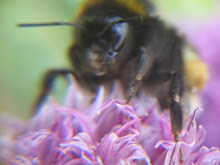skip to main |
skip to sidebar
 In my quest to get good photos of bees I spent ages crawling about on my knees following a bumblebee as it circled and hummed about a particular patch of ground. It then went under a leaf and stopped moving. So i waited - and waited for it to come out from under the leaf. And waited.
In my quest to get good photos of bees I spent ages crawling about on my knees following a bumblebee as it circled and hummed about a particular patch of ground. It then went under a leaf and stopped moving. So i waited - and waited for it to come out from under the leaf. And waited.
I could hear faint buzzing though... and wondered where it might be. So i moved the leaf only to reveal a hole that the bee had disappeared down. As it goes it came out of another entrance and got away without me getting a photo of it.
So, here is an image of a bee hole!
 My friend sent a text last night to say the Bee Project Open Day event at YSP is mentioned in the Sunday Times Travel section as one of the things to do on May 3rd bank holiday Monday. Cool.
My friend sent a text last night to say the Bee Project Open Day event at YSP is mentioned in the Sunday Times Travel section as one of the things to do on May 3rd bank holiday Monday. Cool.
On the open day I'm giving 2 tours down to the project base at the boathouse - which is not usually open to the general public - and I'll be joined by Ivor Flatman who is the apiarist looking after the YSP bees. Sunday TimesYSPThe image is from my trip to Japan - in Hiroshima
 There is a big patch of daffodils on the sloping lawn under the mansion house towards the lake at YSP and bees seem to love feeding amongst them. I saw this one for the first time there - I think it's Bombus hypnorum Tree bumblebee and the description in my field guide is this:
There is a big patch of daffodils on the sloping lawn under the mansion house towards the lake at YSP and bees seem to love feeding amongst them. I saw this one for the first time there - I think it's Bombus hypnorum Tree bumblebee and the description in my field guide is this:
"Distribution and biology: Newly found in the UK in 2000; this species has been expanding its range steadily in mainland Europe and is now doing so in the UK. It seems to have a close affinity with urban and woodland habitats throughout Europe, where it is widely distributed. This species is double-brooded, with nests-searching queens in march and again in June. New females appear from the end of May to September."

 Last week while at YSP i saw masses of bees - lots of Buff-tailed Bumblebees Bombus terestris, and this time I saw quite a lot of honey bees too feeding on the willow catkins. I also saw a couple of Red-tailed Bumblebees Bombus lapidarius (the images here aren't great but you get to see how glossy velvet it is and the red tail - interestingly i think some of the small pale dots on it might be mites perhaps - they can be seen a bit clearer on the high res photos). The description in my field guide* says this:
Last week while at YSP i saw masses of bees - lots of Buff-tailed Bumblebees Bombus terestris, and this time I saw quite a lot of honey bees too feeding on the willow catkins. I also saw a couple of Red-tailed Bumblebees Bombus lapidarius (the images here aren't great but you get to see how glossy velvet it is and the red tail - interestingly i think some of the small pale dots on it might be mites perhaps - they can be seen a bit clearer on the high res photos). The description in my field guide* says this:
"Distribution: A widespread species found in many habitats. It is currently spreading into north-eastern Scotland.
Nests: Made in a variety of situations, usually in open areas; underground or in wall cavities. Nest-searching queens can be seen from March to June, depending on the distance north. Mature nests are large and frequently contain 150 workers. Young nests are sometimes taken over by the similarly coloured social parasitic species B. repestris. Males are often seen patrolling round isolated bushes or along hedge lines. Newly mated queens may hibernate in large numbers in traditional areas, such as north-facing banks in open woodland."
*The Field Guide to Bumblebees of GB and Ireland by Mike Edwards and Martin Jenner (i love this book)












